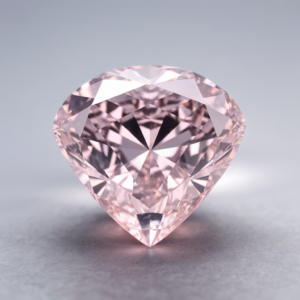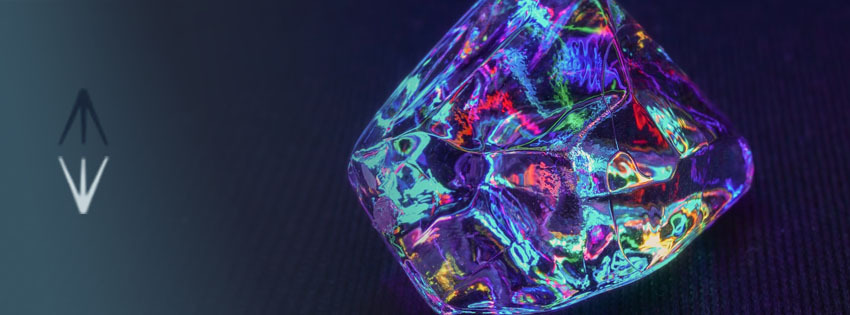Diamonds, symbols of beauty and durability, are classified into various types each with distinctive characteristics that enchant collectors and enthusiasts alike. In this article from diamantes.com we will explore the 12 types of diamonds that exist, highlighting their origins and unique properties. If you wish to understand how these amazing crystals form in nature, you can read more in our detailed article on the formation of diamonds in nature. (Keywords: types of diamonds, diamond characteristics).
Types of Diamonds by Origin
Natural Diamonds
Natural diamonds are formed beneath the Earth’s surface through geological processes that involve high pressures and temperatures over millions of years. These diamonds are highly valued for their authenticity and the geological stories they encapsulate.
Synthetic Diamonds
On the other hand, synthetic diamonds are created in laboratories using technologies that emulate natural conditions, but in a faster way. They are an ethical and less expensive option. For more details on how to differentiate them from natural ones, visit how to identify natural and synthetic diamonds. (Keywords: natural diamonds, synthetic diamonds).
12 Types of Diamonds by Color that exist
The spectrum of colors in diamonds not only adds a unique touch of beauty but also significantly influences their value, use, and demand in the gem and jewelry market.
1. White Diamond
Predominant in the market, the white diamond is valued for its versatility and the way it reflects light, which maximizes its brilliance. It is a classic choice for engagement rings and other fine jewelry pieces, where its purity and elegance are highlighted.

2. Yellow Diamond
This diamond stands out for its vibrant yellow color, which varies from subtle tones to intense hues. The color is due to the presence of nitrogen. They are especially popular in pieces that seek a touch of striking color and usually have more accessible prices compared to other colored diamonds.

3. Blue Diamond
Known for their stunning and deep blue tone, these diamonds are extremely rare and, therefore, very costly. Their color is due to traces of boron and are highly coveted by gem collectors and enthusiasts.

4. Red Diamond
It is one of the rarest and most expensive diamonds in the world. Its red color is due to structural changes during its formation. Due to its rarity, it is commonly sought after by collectors and can reach astronomical prices at auctions.
Do you want to know more about this diamond? Visit our post on Red Diamond: What It Is and you will have all the information about this highly coveted diamond.

5. Green Diamond
Its distinctive green color is the result of exposure to natural radiation. Green diamonds are unusual and fascinate with their connection to the earth and nature, making them exquisite pieces in high-end jewelry.

6. Orange Diamond
This warm color is due to the atomic structure that absorbs light at certain wavelengths. They are quite rare and their unique color makes them desirable in customized jewelry.

7. Black Diamond
With their characteristic dark color, these diamonds are powerful and mysterious. They are opaque and have a unique sheen, making them popular in modern and masculine jewelry.

8. Pink Diamond
Favored for its romanticism and softness, the pink diamond can vary from pale to intense tones. Its color is the result of a rare crystal deformation and is highly sought after in the luxury market.

9. Brown Diamond
Often called “chocolates”, these diamonds are more accessible and are frequently used in fashion jewelry for their warmth and natural hue.

10. Violet Diamond
It is one of the rarest diamonds, and its delicate violet color makes them extremely special and sought after by diamond connoisseurs.

11. Gray Diamond
These diamonds offer discreet sophistication and are valued for their modernity and elegance in contemporary jewelry.

12. Champagne Diamond
Known for their neutral and soft color, they are appreciated for their versatility and accessibility, ideal for those seeking a colored diamond at a reasonable price.

Comparative Table of Diamonds by Color
| Type of Diamond | Value ($) | Purity | Common Use | Rarity |
|---|---|---|---|---|
| White | High | VVS1-VVS2 | Fine jewelry | Common |
| Yellow | Medium | VS1-VS2 | Color rings | Moderately rare |
| Blue | Very high | VVS1 | Collections, auctions | Low |
| Red | Extreme | Flawless | Luxury jewelry, collectors | Extremely rare |
| Green | High | SI1-SI2 | Exclusive pieces | Low |
| Orange | High | VVS2 | Customized jewelry | Low |
| Black | Medium | Varies | Modern jewelry | Moderately rare |
| Pink | Very high | Flawless | High-end jewelry | Low |
| Brown | Low | I1-I2 | Fashion jewelry | Common |
| Violet | Extreme | VVS1 | Exclusive collections | Extremely rare |
| Gray | Medium | SI1-SI2 | Modern jewelry | Moderately rare |
| Champagne | Low | SI2-I1 | Affordable jewelry | Common |
This table summarizes the properties and common uses of each type of diamond, providing a clear view of how they vary in terms of value, purity, preferred application, and their unalterable hardness. These data help consumers and collectors better understand each type and make informed decisions based on their specific needs and aesthetic preferences.
Unique characteristics of each type of diamond
Each type of diamond exhibits unique characteristics that not only determine its value in the market but also influence its specific application. These characteristics include clarity, cut, and carats, fundamental aspects that any buyer or collector should consider.
Clarity of diamonds
A diamond’s clarity refers to the absence of internal imperfections (inclusions) or external blemishes. White diamonds, for example, are rigorously evaluated for their clarity, as even small inclusions can affect their transparent appearance. In contrast, some colored diamonds like black, where inclusions are less noticeable, are more valued for their color and unique texture than for their clarity.
Cut of a diamond
The cut of a diamond not only refers to its shape but to how the diamond’s facets interact with light. A good cut can compensate for lower color tones or lesser clarity by maximizing the brilliance and fire of the diamond. For instance, the cut of a blue diamond must be meticulously planned to enhance its deep color and ensure that it reflects light spectacularly.
Carats of a diamond
Carats measure the weight of the diamond, and therefore, generally its size. However, two diamonds of the same weight can have vastly different values depending on their clarity and cut. Colored diamonds like pink or red, although small in size, can fetch exorbitant prices due to their rarity and demand.
Importance and Use of different types of diamonds
Diamonds are appreciated not only for their aesthetics in jewelry but also for their utility in various industrial applications. Their unmatched hardness makes them ideal for cutting, drilling, grinding, and polishing. There is no other natural material that can compete with diamonds in terms of durability and wear resistance, making them vital in the manufacturing and construction industry.
Types of diamonds in jewelry
Each color and type of diamond reflects a unique personality and status. White diamonds are often associated with engagement rings and celebrations, while colored diamonds are becoming increasingly popular in modern and statement pieces that highlight the wearer’s individuality.
Diamonds in the industry
Beyond jewelry, diamonds are widely used in cutting tools and equipment requiring extremely hard and durable materials. For example, diamonds are fundamental in the manufacture of saws, drills, and other equipment used to cut everything from stones to metals.
Frequently Asked Questions about the different types of diamonds
What type of diamond is the rarest?
The red diamond is one of the rarest and most valued in the world.
What determines the color of a diamond?
Elements like nitrogen and boron can alter the crystal structure of carbon, influencing the color of the diamond.
What is the main difference between a natural and a synthetic diamond?
Natural diamonds form under extreme geological conditions over millions of years, while synthetic ones are created in a much shorter time in laboratories.
Why are some diamonds more valuable than others?
Factors such as rarity, color, clarity, cut, and carats determine the value of a diamond.
Conclusion on the different types of diamonds
Diamonds are more than a mere manifestation of luxury and beauty; they represent a perfect fusion of nature’s whims and the advancements of human science. Choosing the right diamond involves understanding and valuing these unique characteristics that go beyond mere cost. Each type of diamond offers a story and a set of features that may resonate differently with each person, making their choice a deeply personal and significant decision.




